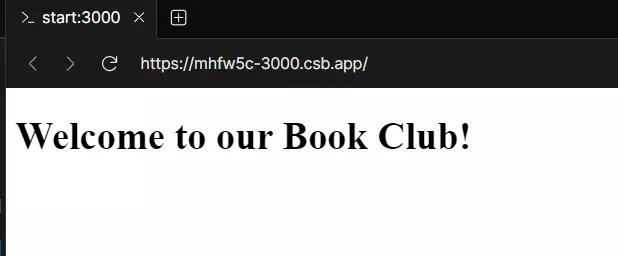This guide demonstrates building a web server using Node.js and Express.js. We'll cover project setup, server configuration, handling various request types, serving static files, and implementing robust error handling.

Key Concepts:
- Simple Web Server Implementation: Learn to create and deploy a functional Node.js web server step-by-step.
- Dynamic Web Application Development: Explore techniques for handling user interactions, dynamic content generation, and form submissions.
- Core Node.js Features: Gain practical experience working with static files, error handling, and request processing.
Part 1: Project Setup
-
Install Node.js and npm: Download and install Node.js from http://m.miracleart.cn/link/8621cdddd12002436862912970737eda. Verify installation using
node -vandnpm -vin your terminal.
-
Project Initialization: Create a project directory, navigate to it, and run
npm init -yto generate apackage.jsonfile. -
Install Express.js: Use
npm install expressto add Express.js as a dependency.
Part 2: Setting Up the Express Server
-
Create
app.js: Create a file namedapp.jsto house your server code. -
Import Express: Add
const express = require('express');at the top ofapp.js. -
Create an Express App: Use
const app = express();to instantiate an Express application. -
Define a Route: Define a route using
app.get('/', (req, res) => { res.send('Hello World!'); });to handle requests to the root path. -
Start the Server: Start the server on port 3000 with
app.listen(3000, () => { console.log('Server listening on port 3000'); });.
Part 3: Enhancing Functionality (Simplified)
This section outlines the key steps; detailed code examples are omitted for brevity.
-
Message Management: Create a
messages.jsfile to store application messages. Import and use these messages in your routes for cleaner code. -
Static File Serving: Create a
publicdirectory for static assets (HTML, CSS, JavaScript). Useapp.use(express.static('public'));to serve these files. -
Handling POST Requests: Install
body-parser(npm install body-parser) to handle form submissions. Create a POST route to process form data and store it (e.g., in an array for this example). -
Data Storage (Simplified): Use an in-memory array to store data (for demonstration purposes only; a database is recommended for production).
-
Error Handling: Implement error handling middleware to gracefully manage exceptions.
-
Serving HTML Pages with EJS: Install EJS (
npm install ejs), set it as the view engine (app.set('view engine', 'ejs');), and create EJS templates in aviewsdirectory to render dynamic HTML.




Conclusion:
This guide provides a foundation for building web servers with Node.js and Express. Remember to replace the in-memory data storage with a proper database solution for production applications. Further exploration of features like WebSockets and advanced database interactions will enhance your server's capabilities.
The above is the detailed content of How to Build a Simple Web Server with Node.js. For more information, please follow other related articles on the PHP Chinese website!

Hot AI Tools

Undress AI Tool
Undress images for free

Undresser.AI Undress
AI-powered app for creating realistic nude photos

AI Clothes Remover
Online AI tool for removing clothes from photos.

Clothoff.io
AI clothes remover

Video Face Swap
Swap faces in any video effortlessly with our completely free AI face swap tool!

Hot Article

Hot Tools

Notepad++7.3.1
Easy-to-use and free code editor

SublimeText3 Chinese version
Chinese version, very easy to use

Zend Studio 13.0.1
Powerful PHP integrated development environment

Dreamweaver CS6
Visual web development tools

SublimeText3 Mac version
God-level code editing software (SublimeText3)

Hot Topics
 Java vs. JavaScript: Clearing Up the Confusion
Jun 20, 2025 am 12:27 AM
Java vs. JavaScript: Clearing Up the Confusion
Jun 20, 2025 am 12:27 AM
Java and JavaScript are different programming languages, each suitable for different application scenarios. Java is used for large enterprise and mobile application development, while JavaScript is mainly used for web page development.
 Javascript Comments: short explanation
Jun 19, 2025 am 12:40 AM
Javascript Comments: short explanation
Jun 19, 2025 am 12:40 AM
JavaScriptcommentsareessentialformaintaining,reading,andguidingcodeexecution.1)Single-linecommentsareusedforquickexplanations.2)Multi-linecommentsexplaincomplexlogicorprovidedetaileddocumentation.3)Inlinecommentsclarifyspecificpartsofcode.Bestpractic
 How to work with dates and times in js?
Jul 01, 2025 am 01:27 AM
How to work with dates and times in js?
Jul 01, 2025 am 01:27 AM
The following points should be noted when processing dates and time in JavaScript: 1. There are many ways to create Date objects. It is recommended to use ISO format strings to ensure compatibility; 2. Get and set time information can be obtained and set methods, and note that the month starts from 0; 3. Manually formatting dates requires strings, and third-party libraries can also be used; 4. It is recommended to use libraries that support time zones, such as Luxon. Mastering these key points can effectively avoid common mistakes.
 Why should you place tags at the bottom of the ?
Jul 02, 2025 am 01:22 AM
Why should you place tags at the bottom of the ?
Jul 02, 2025 am 01:22 AM
PlacingtagsatthebottomofablogpostorwebpageservespracticalpurposesforSEO,userexperience,anddesign.1.IthelpswithSEObyallowingsearchenginestoaccesskeyword-relevanttagswithoutclutteringthemaincontent.2.Itimprovesuserexperiencebykeepingthefocusonthearticl
 JavaScript vs. Java: A Comprehensive Comparison for Developers
Jun 20, 2025 am 12:21 AM
JavaScript vs. Java: A Comprehensive Comparison for Developers
Jun 20, 2025 am 12:21 AM
JavaScriptispreferredforwebdevelopment,whileJavaisbetterforlarge-scalebackendsystemsandAndroidapps.1)JavaScriptexcelsincreatinginteractivewebexperienceswithitsdynamicnatureandDOMmanipulation.2)Javaoffersstrongtypingandobject-orientedfeatures,idealfor
 What is event bubbling and capturing in the DOM?
Jul 02, 2025 am 01:19 AM
What is event bubbling and capturing in the DOM?
Jul 02, 2025 am 01:19 AM
Event capture and bubble are two stages of event propagation in DOM. Capture is from the top layer to the target element, and bubble is from the target element to the top layer. 1. Event capture is implemented by setting the useCapture parameter of addEventListener to true; 2. Event bubble is the default behavior, useCapture is set to false or omitted; 3. Event propagation can be used to prevent event propagation; 4. Event bubbling supports event delegation to improve dynamic content processing efficiency; 5. Capture can be used to intercept events in advance, such as logging or error processing. Understanding these two phases helps to accurately control the timing and how JavaScript responds to user operations.
 JavaScript: Exploring Data Types for Efficient Coding
Jun 20, 2025 am 12:46 AM
JavaScript: Exploring Data Types for Efficient Coding
Jun 20, 2025 am 12:46 AM
JavaScripthassevenfundamentaldatatypes:number,string,boolean,undefined,null,object,andsymbol.1)Numbersuseadouble-precisionformat,usefulforwidevaluerangesbutbecautiouswithfloating-pointarithmetic.2)Stringsareimmutable,useefficientconcatenationmethodsf
 How can you reduce the payload size of a JavaScript application?
Jun 26, 2025 am 12:54 AM
How can you reduce the payload size of a JavaScript application?
Jun 26, 2025 am 12:54 AM
If JavaScript applications load slowly and have poor performance, the problem is that the payload is too large. Solutions include: 1. Use code splitting (CodeSplitting), split the large bundle into multiple small files through React.lazy() or build tools, and load it as needed to reduce the first download; 2. Remove unused code (TreeShaking), use the ES6 module mechanism to clear "dead code" to ensure that the introduced libraries support this feature; 3. Compress and merge resource files, enable Gzip/Brotli and Terser to compress JS, reasonably merge files and optimize static resources; 4. Replace heavy-duty dependencies and choose lightweight libraries such as day.js and fetch







